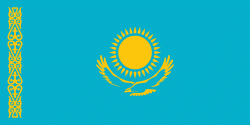Kazakh language
Kazakh or Qazaq (Latin: qazaqşa or qazaq tılı, Cyrillic: қазақша or қазақ тілі, Arabic Script: قازاقشا or قازاق تيلي,, ) is a Turkic language of the Kipchak branch spoken in Central Asia by Kazakhs. It is closely related to Nogai, Kyrgyz and Karakalpak. It is the official language of Kazakhstan and a significant minority language in the Ili Kazakh Autonomous Prefecture in Xinjiang, north-western China and in the Bayan-Ölgii Province of western Mongolia. The language is also spoken by many ethnic Kazakhs throughout the former Soviet Union (some 472,000 in Russia according to the 2010 Russian Census), Germany, and Turkey.
Like other Turkic languages, Kazakh is an agglutinative language and employs vowel harmony. Ethnologue recognizes three mutually intelligible dialect groups, Northeastern Kazakh, the most widely spoken variety which also serves as the basis for the standard language, Southern Kazakh and Western Kazakh. The language share a degree of mutual intelligiblity with closely related Karakalpak while its Western dialects maintain limited mutual intelligibility with Altai languages.
In October 2017, Kazakh president Nursultan Nazarbayev decreed that the writing system would change from using Cyrillic to Latin script by 2025. The proposed Latin alphabet has been revised several times and as of January 2021 is close to the inventory of the Turkish alphabet, though lacking the letters C and Ç and having four additional letters: Ä, Ñ, Q and Ū (though other letters such as Y have different values in the two languages). It is scheduled to be phased in from 2023 to 2031.
Speakers of Kazakh (mainly Kazakhs) are spread over a vast territory from the Tian Shan to the western shore of the Caspian Sea. Kazakh is the official state language of Kazakhstan, with nearly 10 million speakers (based on information from the CIA World Factbook on population and proportion of Kazakh speakers).
In China, nearly two million ethnic Kazakhs and Kazakh speakers reside in the Ili Kazakh Autonomous Prefecture of Xinjiang.
Like other Turkic languages, Kazakh is an agglutinative language and employs vowel harmony. Ethnologue recognizes three mutually intelligible dialect groups, Northeastern Kazakh, the most widely spoken variety which also serves as the basis for the standard language, Southern Kazakh and Western Kazakh. The language share a degree of mutual intelligiblity with closely related Karakalpak while its Western dialects maintain limited mutual intelligibility with Altai languages.
In October 2017, Kazakh president Nursultan Nazarbayev decreed that the writing system would change from using Cyrillic to Latin script by 2025. The proposed Latin alphabet has been revised several times and as of January 2021 is close to the inventory of the Turkish alphabet, though lacking the letters C and Ç and having four additional letters: Ä, Ñ, Q and Ū (though other letters such as Y have different values in the two languages). It is scheduled to be phased in from 2023 to 2031.
Speakers of Kazakh (mainly Kazakhs) are spread over a vast territory from the Tian Shan to the western shore of the Caspian Sea. Kazakh is the official state language of Kazakhstan, with nearly 10 million speakers (based on information from the CIA World Factbook on population and proportion of Kazakh speakers).
In China, nearly two million ethnic Kazakhs and Kazakh speakers reside in the Ili Kazakh Autonomous Prefecture of Xinjiang.
Country
-
Kazakhstan
Kazakhstan, officially the Republic of Kazakhstan, is a transcontinental country located mainly in Central Asia and partly in Eastern Europe. It borders Russia to the north and west, China to the east, Kyrgyzstan to the southeast, Uzbekistan to the south, and Turkmenistan to the southwest, with a coastline along the Caspian Sea. Its capital is Astana, known as Nur-Sultan from 2019 to 2022. Almaty, Kazakhstan's largest city, was the country's capital until 1997. Kazakhstan is the world's largest landlocked country, the largest and northernmost Muslim-majority country by land area, and the ninth-largest country in the world. It has a population of 19 million people, and one of the lowest population densities in the world, at fewer than 6 people per square kilometre (15 people per square mile).
The country dominates Central Asia economically and politically, generating 60 percent of the region's GDP, primarily through its oil and gas industry; it also has vast mineral resources. Officially, it is a democratic, secular, unitary, constitutional republic with a diverse cultural heritage, and has the highest Human Development Index ranking in the region. Kazakhstan is a member state of the United Nations, World Trade Organization, Commonwealth of Independent States, Shanghai Cooperation Organisation, Eurasian Economic Union, Collective Security Treaty Organization, Organization for Security and Cooperation in Europe, Organization of Islamic Cooperation, Organization of Turkic States, and International Organization of Turkic Culture.
